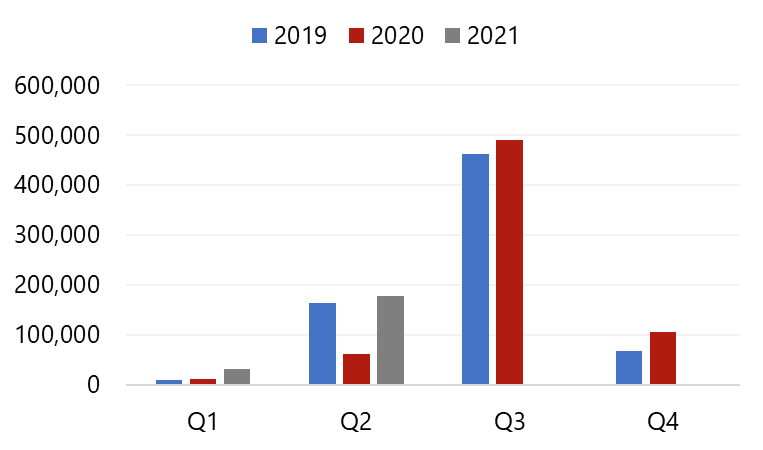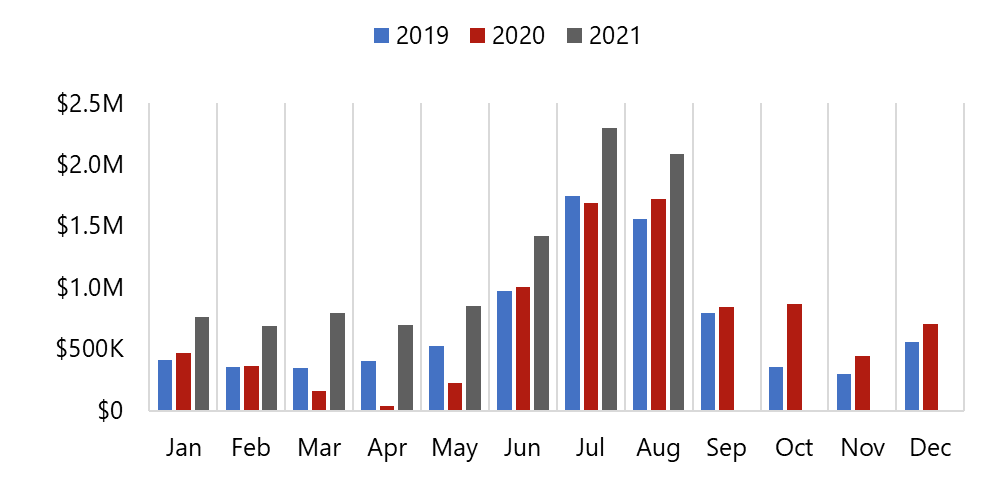Historical Overview
In a 2019 article, we highlighted the foundations of the Bend, Oregon, market. As a recap, Bend is a drive-to destination situated east of the Cascade mountain range in Central Oregon that enjoys nearly 300 days of sunshine per year, making it an attractive leisure destination for Portland and Seattle residents. In addition to tourism, Bend’s economy is diversified by the presence of Oregon State University (OSU) and St. Charles Health System. The expansion of the local economy from 2010 through 2019, which was bolstered by a growing population, allowed for the opening of eight hotels totaling over 600 guestrooms across a variety of product classes.
Recent Trends and COVID-19 Impact
Virtually all tourism-related travel ceased following the onset of the COVID-19 pandemic in March 2020; however, this severe decline in travel was temporary for the greater Bend market, only lasting until May. Following the corporate shift to remote work nationwide, Central Oregon, particularly the greater Bend market, experienced a significant increase in demand. Market participants reported that vacation rentals, such as Airbnb and Vrbo, increased exponentially, and local hotels and resorts began to see longer average stays. Simultaneously, 2020 visitation statistics for Crater Lake National Park in the months of July, August, and December shattered all historical visitation records, while visitation in the months of October and November surpassed 2019 levels.
Wildfires are a standard risk during the summertime for the Pacific Northwest; however, 2020 was a relatively historic year for wildfires, primarily during the months of September and October. During that time, wildfires blazed through the region, including the Beachie Creek, Holiday Farm, and Lionshead fires that were located northwest of Bend. Significant evacuations followed, during which many displaced residents relocated to either Bend or Redmond. Due to hazardous air quality in the greater Bend area, tourism was negatively affected, which is illustrated in the Crater Lake National Park visitation levels for the month of September in particular. However, lost tourism-related demand due to the poor air quality was partially supplemented by displaced residents. Notably, record-breaking transient room tax (TRT) collections were registered for the months of September and October of 2020. [1]
Transient Room Tax (TRT) Collections
Source: City of Bend
In addition to increased tourism-related demand, OSU has also grown since 2019. After a period of online learning following the onset of the pandemic, OSU returned to onsite campus activity beginning in July 2020; enhanced cleaning and sanitation efforts were implemented, along with tracing efforts, increased testing availability, and recommendations for face coverings. OSU experienced record enrollment levels for the Fall 2020 semester, despite the impact of the COVID-19 pandemic, with enrollment growth fueled by increases in the Ecampus online programs and at the Cascades campus in Bend. Conversely, enrollment levels at the OSU main campus in Corvallis declined during the same period. Nonetheless, the number of students at the OSU Cascades campus continued to rise in 2021, registering a 13% increase for the Spring semester.
Historical Effects of Hotel Supply Changes
The overall strength and resilience of the local market is further illustrated by the relatively fast absorption of new hotel supply historically. According to STR and the City of Bend, available room nights increased by approximately 13.5% between 2017 and 2018; however, RevPAR essentially experienced no negative impact from the addition of the new supply, only registering a 1% decline in 2019. Furthermore, despite the opening of a 109-room hotel in the summer of 2020 and the initial impact of the COVID-19 pandemic, overall RevPAR in the Bend market only declined by about 35% in 2020. This trend was much less severe than that of Portland, which experienced a 64% decline in RevPAR in 2020. Lastly, the Element by Westin opened in early 2021, adding 112 more rooms to the market. Remarkably, despite the entrance of new supply, RevPAR through September 2021 illustrates an increase of approximately 60% compared to the same period of 2020, with growth equally fueled by occupancy and ADR.[2] Visitation data for Crater Lake National Park through August 2021 further illustrate the area’s high demand levels, with the months of January through May breaking records.
Looking Forward
The lifting of most travel restrictions for fully vaccinated international visitors on November 8, 2021, is expected to result in only a slight correction in demand, as new international travel is likely to supplement most lost domestic demand. While the induced domestic travel to Bend through the year-to-date period is anticipated to decline as international borders continue to reopen and demand normalizes, demand from those working remotely is largely expected to continue. Furthermore, some new hotel projects are in the early planning stages, but the timelines for completion are largely unknown at this time. We expect that new hotel development going forward will likely induce demand and promote RevPAR growth, primarily through ADR increases. Overall, the greater Bend area benefits from its drive-to, outdoor-oriented location within Central Oregon, as illustrated by the strength and resilience of the market over the last two years.
For more detailed forecasts or to inquire about a specific hotel project, contact Lauren Reynolds, Kasia Russell, Breanna Smith, and/or Eileen Bosworth of our Portland team.




